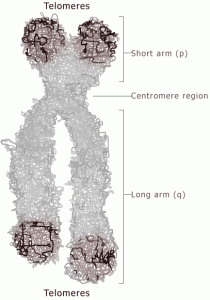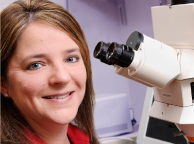Congratulations to Elizabeth Blackburn, Carol Greider and Jack Szostak for the 2009 Nobel Prize in medicine. The award is for their work on telomeres, the protective caps on the ends of chromosomes that shorten with every cell division and need specialized enzymes to be replenished.
Greider, Blackburn and Szostak discovered telomerase, the enzyme that copies the ends of chromosomes using a special RNA template. Telomerase is turned off in most human cells, but cancer cells often must reactivate it so that they can keep dividing like crazy.
The discovery of telomerase has led to new leads for potential anticancer drugs. This is a good example of the impact basic research can have on medicine, since the prize-winners were not thinking about anticancer drugs in the 1980s when they were doing their work.

Telomeres are specialized protective structures at the ends of chromosomes
The telomere trio’s work relates to several lines of research at Emory.
Immunologist Cornelia Weyand and her colleagues have shown that the telomeres of T cells are abnormally shortened in patients with rheumatoid arthritis. In effect, their cells’ chromosomes are prematurely aged. This result provides some hints on how to treat autoimmune diseases.
If blood-forming stem cells can’t keep their telomeres in shape, they can’t continue to regenerate the blood. Pathologist Hinh Ly’s research has made a connection between genetic defects in telomere maintenance and bone marrow failure syndrome in human patients.
Geneticists Christa Martin and David Ledbetter have been probing the relationship between mutations or recombination in the regions of the chromosome adjacent to telomeres and developmental disorders such as autism and mental retardation.
The 2009 Nobel Prize in Chemistry, awarded to Venki Ramakrishnan, Tom Steitz and Ada Yonath, has an even stronger connection to Emory. Christine Dunham, part of a growing contingent of crystallographers here, worked on ribosome structure in Ramakrishnan’s lab at the MRC.

The ribosome is a machine that decodes mRNA and produces protein step by step
She is examining the molecular details of how antibiotics and viruses perturb ribosome function.
What the two Nobels have in common is that they both honor work on molecular machines containing RNA, connections to the ancient, shadowy “RNA world“.
Posted on
October 7, 2009 by
Quinn Eastman
in Uncategorized









